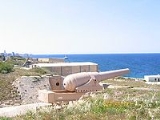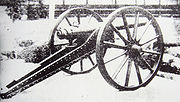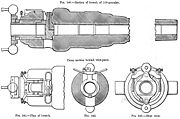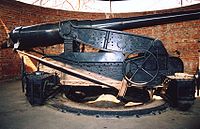
Armstrong Gun
Encyclopedia

William George Armstrong, 1st Baron Armstrong
William George Armstrong, 1st Baron Armstrong CB, FRS was an effective Tyneside industrialist who founded the Armstrong Whitworth manufacturing empire.-Early life:...
and manufactured in England from 1855 by the Elswick Ordnance Company and the Royal Arsenal
Royal Arsenal
The Royal Arsenal, Woolwich, originally known as the Woolwich Warren, carried out armaments manufacture, ammunition proofing and explosives research for the British armed forces. It was sited on the south bank of the River Thames in Woolwich in south-east London, England.-Early history:The Warren...
at Woolwich
Woolwich
Woolwich is a district in south London, England, located in the London Borough of Greenwich. The area is identified in the London Plan as one of 35 major centres in Greater London.Woolwich formed part of Kent until 1889 when the County of London was created...
. The term has also been used to describe Armstrong's built-up gun
Built-up gun
The term built-up gun describes a construction technique for artillery barrels. An inner tube of metal which stretches most within its elastic limit enlarges under the pressure of confined powder gases to transmit stress to outer cylinders under tension...
construction system of a wrought-iron (later of mild steel) tube surrounded by multiple wrought-iron strengthening coils shrunk over the inner tube to keep it under compression.
The Armstrong rifled breechloading guns of the 1850s-1860s
In 1854 Armstrong approached the Secretary of State for WarSecretary of State for War
The position of Secretary of State for War, commonly called War Secretary, was a British cabinet-level position, first held by Henry Dundas . In 1801 the post became that of Secretary of State for War and the Colonies. The position was re-instated in 1854...
, proposing that he construct a rifled breech-loading
Rifled breech loader
A rifled breech loader is an artillery piece which, unlike the smooth-bore cannon and rifled muzzle loader which preceded it, has rifling in the barrel and is loaded from the breech at the rear of the gun....
3-pounder gun for trial. Later increased in bore to 5-pounder, the design performed successfully with respect to both range and accuracy. Over the next three years he developed his system of construction and adapted it to guns of heavier calibre.
Armstrong's system was adopted in 1858, initially for "special service in the field" and initially he only produced smaller artillery
Artillery
Originally applied to any group of infantry primarily armed with projectile weapons, artillery has over time become limited in meaning to refer only to those engines of war that operate by projection of munitions far beyond the range of effect of personal weapons...
pieces, 6-pounder (2.5 in/64 mm) mountain or light field guns, 9-pounder (3 in/76 mm) guns for horse artillery
Horse artillery
Horse artillery was a type of light, fast-moving and fast-firing artillery which provided highly mobile fire support to European and American armies from the 17th to the early 20th century...
, and 12-pounder (3 inches /76 mm) field guns
RBL 12 pounder 8 cwt Armstrong gun
The Armstrong Breech Loading 12 pounder 8 cwt, later known as RBL 12 pounder 8 cwt, was an early modern 3-inch rifled breech-loading field gun of 1859.-Design:The gun incorporated some advanced features for its day...
.
Armstrong did not consider his system suited to heavier guns but higher authorities had him develop a 20-pounder (3.75 inches /95 mm) field & naval gun
RBL 20 pounder Armstrong gun
The Armstrong Breech Loading 20 pounder gun, later known as RBL 20 pounder, was an early modern 3.75 inch rifled breech-loading light gun of 1859.-History:The gun was effectively a larger version of the successful RBL 12 pounder 8 cwt Armstrong gun...
, a 40-pounder (4.75 inches (120.7 mm)) siege gun
RBL 40 pounder Armstrong gun
The Armstrong RBL 40 pounder gun was an early attempt to use William Armstrong's new and innovative breechloading mechanism for medium artillery.-Design history:...
, and a 110-pounder (7 inches /180 mm) heavy gun. The Royal Navy
Royal Navy
The Royal Navy is the naval warfare service branch of the British Armed Forces. Founded in the 16th century, it is the oldest service branch and is known as the Senior Service...
used all these guns and all except the 20-pounder saw service in New Zealand
New Zealand
New Zealand is an island country in the south-western Pacific Ocean comprising two main landmasses and numerous smaller islands. The country is situated some east of Australia across the Tasman Sea, and roughly south of the Pacific island nations of New Caledonia, Fiji, and Tonga...
.
Armstrong breech-loading system



Wrought iron
thumb|The [[Eiffel tower]] is constructed from [[puddle iron]], a form of wrought ironWrought iron is an iron alloy with a very low carbon...
, and from 1863 of mild steel toughened in oil) holding the bore over which were shrunk several wrought iron
Wrought iron
thumb|The [[Eiffel tower]] is constructed from [[puddle iron]], a form of wrought ironWrought iron is an iron alloy with a very low carbon...
coils which kept the central tube under compression, a breech-piece, and a trunnion
Trunnion
A trunnion is a cylindrical protrusion used as a mounting and/or pivoting point. In a cannon, the trunnions are two projections cast just forward of the centre of mass of the cannon and fixed to a two-wheeled movable gun carriage...
ring. The guns' rifling was on the "polygroove" system; the bore of the gun had 38 grooves along its length with a twist of one turn per 38 calibres.
The cast iron
Cast iron
Cast iron is derived from pig iron, and while it usually refers to gray iron, it also identifies a large group of ferrous alloys which solidify with a eutectic. The color of a fractured surface can be used to identify an alloy. White cast iron is named after its white surface when fractured, due...
shell, similar in shape to a Minié ball
Minié ball
The Minié ball is a type of muzzle-loading spin-stabilising rifle bullet named after its co-developer, Claude-Étienne Minié, inventor of the Minié rifle...
, had a thin lead coating which made it fractionally larger than the gun's bore and which engaged with the gun's rifling
Rifling
Rifling is the process of making helical grooves in the barrel of a gun or firearm, which imparts a spin to a projectile around its long axis...
grooves to impart spin to the shell. This system had just been developed by Martin von Wahrendorff
Martin von Wahrendorff
Martin von Wahrendorff was a Swedish diplomat and inventor.His father Anders von Wahrendorff was the owner of the gun foundry at Åker. In 1837 Wahrendorff applied for patent on a new breech mechanism, later known as the Wahrendorff breech. The first breech loaded Wahrendorff gun was manufactured...
and Giovanni Cavalli in Sweden. This spin, together with the elimination of windage as a result of the tight fit, enabled the gun to achieve greater range and accuracy than existing smoothbore muzzle-loaders with a smaller powder charge.
On top of each gunpowder cartridge was a "lubricator" consisting of tallow and linseed oil between two tin plates, backed by a felt wad coated with beeswax and finally by millboard. The lubricator followed the shell down the bore, the lubricant was squeezed out between the tin plates and the wad behind it cleaned out any lead deposits left from the shell coating leaving the bore clean for the next round.
An innovative feature which is more usually associated with 20th-century guns was what Armstrong called its "grip", which was essentially a squeeze bore
Gauge (bore diameter)
The gauge of a firearm is a unit of measurement used to express the diameter of the barrel. Gauge is determined from the weight of a solid sphere of lead that will fit the bore of the firearm, and is expressed as the multiplicative inverse of the sphere's weight as a fraction of a pound . Thus...
; the last 6 inches of the bore, at the muzzle end was of slightly smaller diameter, which centered the shell before it left the barrel and at the same time, slightly swage
Swage
Swaging is a forging process in which the dimensions of an item are altered using a die or dies, into which the item is forced. Swaging is usually a cold working process; however, it is sometimes done as a hot working process....
d down its lead coating, reducing its diameter and slightly improving its ballistic qualities.
The Armstrong breech loaders used a vertical sliding block, called a vent-piece, which had a conical copper-ringed plug on its front surface which sealed the firing chamber, to close the breech. To hold both block and plug tightly in place the guns used a hollow breech screw (hence the name "screw breech") behind the block, which the gunner rotated to tighten and seal the breech before firing.
To load and fire the gun :
- The breech screw was turned to loosen it
- The vent-piece was raised;
- The shell was inserted through the hollow breech-screw and rammed home into the bore;
- The powder cartridge was inserted through the breech-screw into the chamber;
- A primer tube was inserted into the vent piece (only necessary for the 40-pounderRBL 40 pounder Armstrong gunThe Armstrong RBL 40 pounder gun was an early attempt to use William Armstrong's new and innovative breechloading mechanism for medium artillery.-Design history:...
and 110-pounder due to the size) - The vent-piece was lowered;
- The breech-screw was tightened;
- A friction tube with lanyard attached was inserted in the hole at the top of the vent-piece;
- The gunner pulled the lanyard which ignited a gunpowder charge in the vent tube, the flash passed through the vent in the vent-piece, assisted by the primer if present, into the powder chamber and ignited the gunpowder charge.
Armstrong guns in action
The British used Armstrong guns extensively to great effect in the Second Opium WarSecond Opium War
The Second Opium War, the Second Anglo-Chinese War, the Second China War, the Arrow War, or the Anglo-French expedition to China, was a war pitting the British Empire and the Second French Empire against the Qing Dynasty of China, lasting from 1856 to 1860...
. As reported by the translator Robert Swinhoe, after the British attack on the Chinese fort at Pehtang
Beitang
Beitang , formerly also known as Pei-t'ang and Pehtang , is a subdistrict of Tanggu District, Tianjin, China, located near the mouth of the Hai He....
:
Numbers of dead Chinese lay about the guns, some most fearfully lacerated. The wall afforded very little protection to the Tartar gunners, and it was astonishing how they managed to stand so long against the destructive fire that our Armstrongs poured on them; but I observed, in more instances than one, that the unfortunate creatures had been tied to the guns by the legs."
The Armstrong gun-mainly the 12 pounders was used extensively in the 1863 conflict in New Zealand between the British Troops and rebel Maori in the Waikato. A well preserved 12 pounder is at the Te Awamutu museum which was used in the battle of Rangiriri.The barrel can traverse 6 degrees left or right without moving the gun carriage. The wheels are wooden with a 75mm wide steel band. Wheel diameter is 1.700m. Track width is 1.800m. Barrel width at the muzzle is 140mm. Such was the confidence of the army in the accuracy of the gun that at the battle of Hairini Ridge the artillery was fired over the heads of the advancing infantry as they stormed the ridge.The infantry took cover in a slight depression in the ground in front of the Maori trenches and then stormed the trenches when the shelling stopped.
Return to muzzle-loading guns
In 1863 an OrdnanceAmmunition
Ammunition is a generic term derived from the French language la munition which embraced all material used for war , but which in time came to refer specifically to gunpowder and artillery. The collective term for all types of ammunition is munitions...
Select Committee met to consider the merits of muzzle-loading and breech-loading guns. In 1864, even before they had concluded their investigations, the Government stopped the manufacture of Armstrong breech-loaders. When the Committee finally reported, in August 1865, they announced that:
Their report did admit that Armstrongs' guns, while more expensive, were undoubtedly safer in that while it was not uncommon for cast iron muzzle-loaders to burst (see below), not one Armstong gun had ever done so. (Furthermore, gunners could clear a hang fire
Hang fire
Hang fire refers to an unexpected delay between the triggering of a firearm and the ignition of the propellant. This failure was common in firearm actions that relied on open primer pans, due to the poor or inconsistent quality of the powder. Modern weapons are susceptible, particularly if the...
from the breech; when the RML 17.72 inch gun at Napier of Magdala Battery
Napier of Magdala Battery
Napier of Magdala Battery is a coastal battery on the south-western cliffs of the British overseas territory of Gibraltar, overlooking the Bay of Gibraltar near Rosia Bay.-History:...
at Gibraltar hung fire, a gunner had to be lowered head-first down the bore to attach an extractor to the shell.)
Despite a further report which remarked on the advantages of breech-loaders, cost dominated the proceedings and the Committee finally announced that "The balance of advantages is in favour of muzzle-loading field guns" and in 1865 Britain reverted from breech-loading ordnance to muzzle-loading.
Tests conducted in 1859 with the Armstrong 40-pounder, and again in 1869 with the Armstrong rifled 100-pounder had demonstrated that neither rifled cannon were capable of penetrating 4 inches of armor, even at as little as 50 yards. This was crucial because Britain, as a maritime power, relied for its security on the ability of its naval ordnance to defeat any new armour-protected warships being developed by potential enemy powers.
Armstrong developed an alternative horizontal sliding wedge version of his breechloader, for 40-pounder and 64-pounder guns , in an attempt to address the limitations of the screw breech, but the Government had already decided to return to muzzle-loading guns.
To allow rifling to be used with muzzle-loaders, Armstrong proposed in 1866 a new system whereby the shells had studs on the outside, which aligned with grooves in the barrel of the cannon
Cannon
A cannon is any piece of artillery that uses gunpowder or other usually explosive-based propellents to launch a projectile. Cannon vary in caliber, range, mobility, rate of fire, angle of fire, and firepower; different forms of cannon combine and balance these attributes in varying degrees,...
. This was adopted by the Government for the first generation of rifled muzzle-loaders, termed "RML", together with Armstrong's built up wrought-iron construction method which was still considered sound.
Later Armstrong breechloaders

Interrupted screw
An interrupted screw or interrupted thread is a mechanical device typically used in the breech of artillery guns. It was invented circa 1845....
breech with its own "Armstrong cup" and later the de Bange methods of sealing the bore which relied upon the power of the gun's firing to effect the gas seal ("obturation") rather than the manual labour in the 1858 design. It was a major supplier of modern "BL" guns to the Royal Navy, British Army and the world export market until the 1920s. However, it is its earlier generations of "RBL" guns that are typically referred to as "Armstrong guns".
See also
- Rifled breech loaderRifled breech loaderA rifled breech loader is an artillery piece which, unlike the smooth-bore cannon and rifled muzzle loader which preceded it, has rifling in the barrel and is loaded from the breech at the rear of the gun....
- Disappearing gunDisappearing gunA disappearing gun is a type of heavy artillery for which the gun carriage enabled the gun to rotate backwards and down into a pit protected by a wall or a bunker after it was fired...
for the Armstrong Disappearing Gun.
External links
- Friedrich Engels, “On Rifled Cannon," articles from the New York Tribune, April, May and June, 1860, reprinted in Military Affairs 21, no. 4 (Winter 1957) ed. Morton Borden, 193-198.

